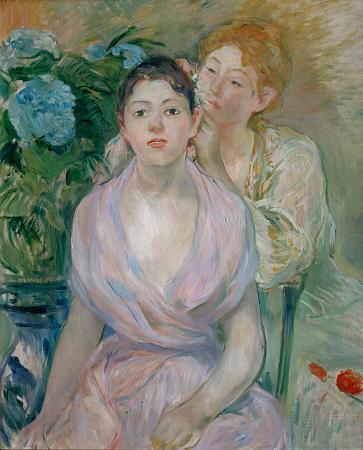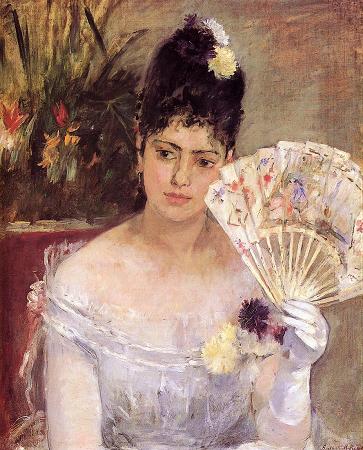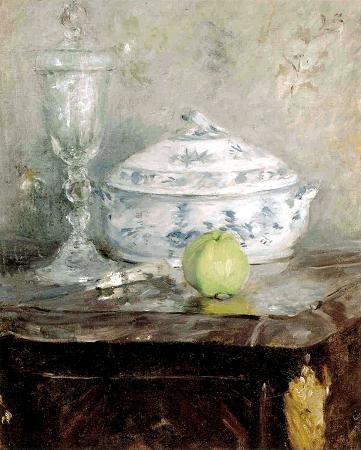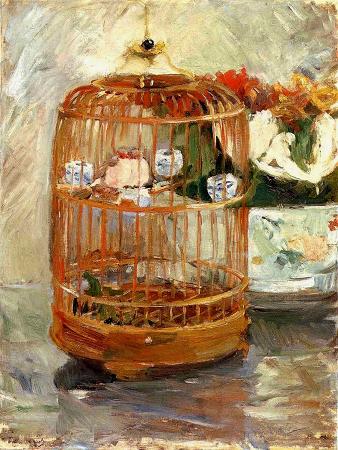Berthe Morisot (1841 - 1895). Berthe Marie Pauline Morisot was a painter and a member of the circle of painters in Paris who became known as the Impressionists. She was described by Gustave Geffroy in 1894 as one of les trois grandes dames of Impressionism alongside Marie Bracquemond and Mary Cassatt. In 1864, Morisot exhibited for the first time in the highly esteemed Salon de Paris. Sponsored by the government and judged by Academicians, the Salon was the official, annual exhibition of the Académie des beaux-arts in Paris. Her work was selected for exhibition in six subsequent Salons until, in 1874, she joined the rejected Impressionists in the first of their own exhibitions, which included Paul Cézanne, Edgar Degas, Claude Monet, Camille Pissarro, Pierre-Auguste Renoir and Alfred Sisley. It was held at the studio of the photographer Nadar. Morisot was married to Eugène Manet, the brother of her friend and colleague Édouard Manet. Morisot was born in Bourges, France, into an affluent bourgeois family. Her father, Edmé Tiburce Morisot, was the prefect of the department of Cher. He also studied architecture at École des Beaux Arts. Her mother, Marie-Joséphine-Cornélie Thomas, was the great-niece of Jean-Honoré Fragonard, one of the most prolific Rococo painters of the ancien régime. She had two older sisters, Yves and Edma, plus a younger brother, Tiburce, born in 1848. The family moved to Paris in 1852, when Morisot was a child. It was commonplace for daughters of bourgeois families to receive art education, so Berthe and her sisters Yves and Edma were taught privately by Geoffroy-Alphonse Chocarne and Joseph Guichard. Morisot and her sisters initially started taking lessons so that they could each make a drawing for their father for his birthday. In 1857 Guichard, who ran a school for girls in Rue des Moulins, introduced Berthe and Edma to the Louvre gallery where from 1858 they learned by copying paintings. The Morisots were not only forbidden to work at the museum unchaperoned, but they were also totally barred from formal training. Guichard also introduced them to the works of Gavarni. As art students, Berthe and Edma worked closely together until 1869, when Edma married Adolphe Pontillon, a naval officer, moved to Cherbourg, and had less time to paint. Letters between the sisters show a loving relationship, underscored by Berthe's regret at the distance between them and Edma's withdrawal from painting. Edma wholeheartedly supported Berthe's continued work and their families always remained close. Edma wrote I am often with you in thought, dear Berthe. I'm in your studio and I like to slip away, if only for a quarter of an hour, to breathe that atmosphere that we shared for many years. Her sister Yves married Theodore Gobillard, a tax inspector, in 1866 and was painted by Edgar Degas as Mrs Theodore Gobillard. As a copyist at the Louvre Morisot met and befriended other artists such as Manet and Monet. In 1861 she was introduced to Jean-Baptiste-Camille Corot, the pivotal landscape painter of the Barbizon school who also excelled in figure painting. Under Corot's influence she took up the plein air method of working. By 1863 she was studying under Achille Oudinot, another Barbizon painter. In the winter of 1863-64 she studied sculpture under Aimé Millet, but none of her sculpture is known to survive. It is hard to trace the stages of Morisot's training and to tell the exact influence of her teachers because she was never pleased with her work and she destroyed nearly all of the artworks she produced before 1869. Her first teacher, Geoffroy-Alphonse Chocarne, taught her the basics of drawing. After several months, Morisot began to take classes taught by Guichard. During this period, she drew mostly ancient classical figures. When Morisot expressed her interests in plein-air painting, Guichard sent her to follow Corot and Oudinot. Painting outdoors, she used watercolors which are easy to carry. At that time, Morisot also became interested in pastel. During this period, Morisot still found oil painting difficult, and worked mostly in watercolor. Her choice of colors is rather restrained; however, the delicate repetition of hues renders a balanced effect. Due to specific characteristics of watercolors as a medium, Morisot was able to create a translucent atmosphere and feathery touch, which contribute to the freshness in her paintings. Having become more confident about oil painting, Morisot worked in oil, watercolor and pastel at the same time, as Degas did. She painted very quickly but did much sketching as preparation, so she could paint a mouth, eyes, and a nose with a single brushstroke.
more...














